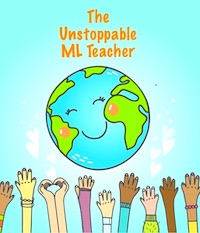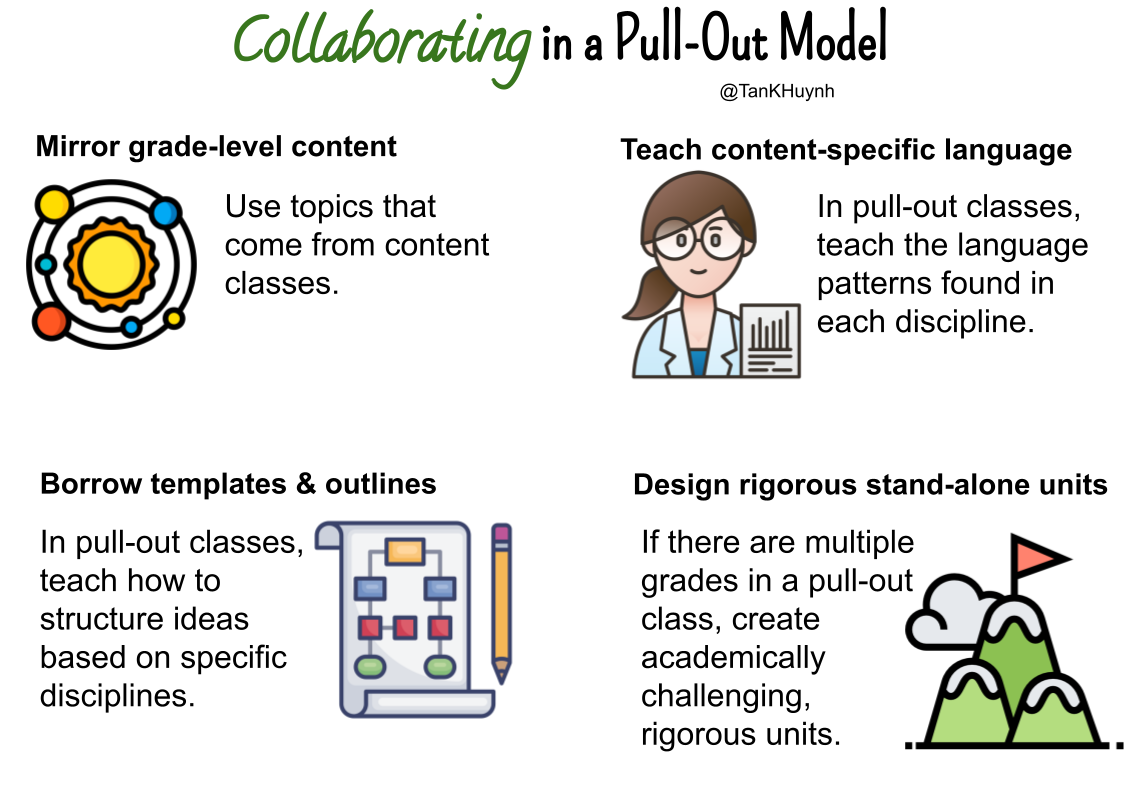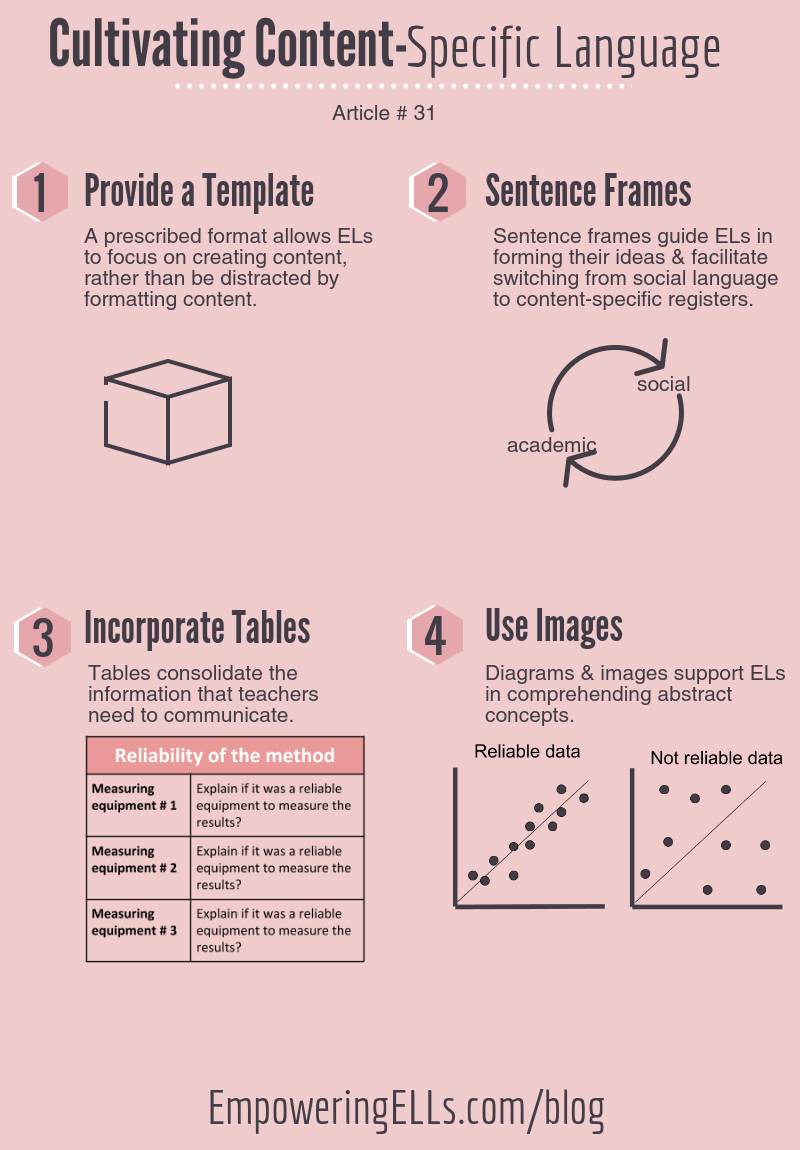How Pull-Out Models Can Be Collaborative
A MiddleWeb Blog
 Some time back, I was praising the virtues of co-planning and co-teaching, presenting them during a webinar as the ideal model for equitable service for multilinguals (Honigsfeld & Dove, 2019).
Some time back, I was praising the virtues of co-planning and co-teaching, presenting them during a webinar as the ideal model for equitable service for multilinguals (Honigsfeld & Dove, 2019).
During the Q&A section, a participant with an edge to her voice asked in frustration, “I would love to co-teach this way, but what if you work in a pull-out model where there is no collaboration?”
It’s a valid question.
Co-planning and co-teaching are one way we can serve multilinguals, but it is not the only way to collaborate with colleagues. It will take some creative thinking, but making our pull-out programs collaborative and equitable is possible.
I will use two hypothetical educators, a language specialist named Ms. Fatima and a social studies teacher named Mrs. Sanderson, to show you how.
Mirror grade-level content
Ms. Fatima can ask the literature, science, and social studies content teachers for the topics in their units. Then she can pick one of the topics shared by her colleagues and plan her unit around it. For example, the units for Mrs. Sanderson’s 6th-grade social studies unit are:
- Unit 1: ecosystems
- Unit 2: geography
- Unit 3: the Industrial Revolution
- Unit 4: globalization
In the pull-out classes, Fatima can plan her language development units around the ecosystem, geography, the Industrial Revolution, and globalization. Ideally the units during pull-out classes will run parallel to those of the content classes so students will learn the content at the same time as their peers.
When the pull-out classes mirror the content of the regular classes, language learners will:
- receive front-loading of content
- have extra exposure to the content
- learn the same grade-level specific content and concepts as their peers (Staehr Fenner & Snyder, 2017).
Teach content-specific language
Every discipline has conventions and rules that govern how language is used for that content. Educators need to teach these language expectations explicitly if multilinguals are to be successful academically (Echevarria, Vogt, & Short, 2016).
Pull-out classes provide an exceptional opportunity to teach content-specific language.
In their meeting, Mrs. Sanderson explained to Fatima that students will be describing both how ecosystems function and how they can become out of balance. Fatima then asked for key vocabulary words and phrases that students should use when describing those ecosystems (e.g., impact, consequence, affect, etc.).
In Fatima’s pull-out class, she will help the language learners develop their ability to describe and use the specific vocabulary words. The multilinguals benefit because they are learning how to describe, which is a Tier 2 vocabulary word that frequently appears in other content classes (Beck et al., 2002).
Fatima’s students will be better prepared to achieve academically not only in Mrs. Sanderson’s social studies class but also in any class where students are to describe or when they see the words impact, consequence, and affect.
Borrow the template
Content-specific language shows up at three different levels: word, sentence, and discourse (organization of ideas) (Zwiers, 2014). Sometimes, content teachers will have a template or an outline of how students’ ideas should be presented, such as in a lab report, design portfolio, art critique, biography report, etc.
Examples of discourse (idea organization) for various content areas might be:
- Literature: beginning, middle, end
- Social Studies: context, causes, effects, suggestions
- Design: problem, research, design, evaluation
- Science: research question, hypothesis, experiment set up, data
Multilingual students benefit greatly from learning how to communicate their ideas according to the discourse prescribed by the content teacher.
For example, Fatima learned that Mrs. Sanderson wants students to organize their thoughts according to the above social studies structure (context, causes, effects, suggestions).
Fatima will use the pull-out time to help students present their ideas in this sequence, focusing on the context of the problem and its causes and effects. Explicitly teaching subject-matter discourse raises language learners’ achievement and simultaneously develops their language skills.
Design rigorous stand-alone units
Some pull-out services have multilinguals from different grades coming to the pull-out class at the same time. This presents more challenges; they may not even be learning similar content. But we will just have to be even more creative during our collaboration and planning.
The ideal option is to create a stand-alone unit. However, the unit should follow the language demands of the content classes. For example, Fatima looks at the first units for science and social studies. She notices that one grade level is learning about ecosystems while another is studying astronomy. However, the main language demand for both is to describe. She then creates a stand-alone unit where students are describing something.
Even though the content for Fatima’s stand-alone unit will not come from the science or social studies unit, it still must be developmentally appropriate. The 6th, 7th and 8th graders in Fatima’s class should not be asked to describe various farm animals as this is more appropriate for lower-elementary grades. Not having access to highly challenging, rigorous, grade-level content would widen the achievement gap as beginning language learners can still learn grade-level content (Snyder & Staeher-Fenner, 2021).
Being new to a language does not mean you are new to thinking.
To ensure that stand-alone units taught in pull-out classes remain at a high level, language specialists can ask their content colleagues the following:
- What types of texts are you having students read?
- What types of videos are you having students watch?
- What types of writing are you having students produce?
- What types of thinking are you having students engage with?
- What types of discussions are you having students participate in?
Gathering this data and using it to inform your stand-alone units is a form of collaboration – not ideal, perhaps, but meaningful and equitable.
Conclusion
Sometimes we find ourselves in less than ideal circumstances, but that doesn’t mean we can’t optimize whatever environment we’re in. Though our collaboration in a pull-out model will not result in “co-teaching,” this kind of co-planning adds a layer of academic rigor to the pull-out curriculum.
As we co-plan for our pull-out classes, think of content as the in-breath and language as the out-breath. We need both to survive. Students need to learn grade-level content as much as they need to develop language skills. And language development comes from engaging with content.
When we co-plan with content colleagues, we create learning opportunities for students to engage in demanding academic learning experiences in a safe environment where they receive highly concentrated support from the pull-out service. Our pull-out instruction mustn’t cause students to miss out on grade-level curriculum. If pull-out is watered down, especially for beginners, then these students will be left behind.
If you’re in a school that uses the pull-out model, be a voice for change if you’re able. After all, pull-out programs can support multilinguals, but they should not be the main educational experience students should have throughout the day.
An all-day pull-out is educational segregation.
Instead, language learners need to be part of content classes as much as possible, and language specialists must collaborate with content teachers to support multilingual learners.
To hear my podcast on collaborating on the pull-out model, click here.
References
Beck, I. L., McKeown, M. G., & Kucan, L. (2002). Bringing Words to Life: Robust Vocabulary Instruction. The Guilford Press.
Echevarria, J., Vogt, M. & Short, D. (2016). Making Content Comprehensible for English Learners: The SIOP Model. Pearson.
Honigsfeld, A., & Dove, M. G. (2019). Collaborating for English Learners: A Foundational Guide to Integrated Practices (2nd ed.). Corwin.
Snyder, S. C., & Staehr Fenner, D. (2021). Culturally Responsive Teaching for Multilingual Learners: Tools for Equity. Corwin.
Staehr Fenner, D., & Snyder, S. C. (2017). Unlocking English Learners′ Potential: Strategies for Making Content Accessible. Corwin.
Zeiers, J. (2014). Building Academic Language: Meeting Common Core Standards Across Disciplines, Grades 5-12. Jossey-Bass.
































